Global Isostatic Pressing Market By Offering, By Type, By Process Type, By Capacity, By End Use Industry, By Region & Segmental Insights Trends and Forecast, 2024 – 2034
- Industry: Semiconductors & Electronics
- Report ID: TNR-110-1263
- Number of Pages: 420
- Table/Charts : Yes
- August, 2024
- Base Year : 2024
- No. of Companies : 10+
- No. of Countries : 29
- Views : 10056
- Covid Impact Covered: Yes
- War Impact Covered: Yes
- Formats : PDF, Excel, PPT
The global isostatic pressing market is experiencing robust growth, driven by increasing demand in sectors such as aerospace, automotive, and healthcare. Key trends include the adoption of advanced materials and the integration of automation and digital controls in isostatic pressing systems. Growth drivers include the rising need for high-performance components with superior mechanical properties and the expanding application of isostatic pressing in additive manufacturing.
Opportunities abound in emerging markets, particularly in Asia-Pacific, where industrialization is fueling demand for precision-engineered parts. Additionally, advancements in material science and the ongoing shift toward lightweight, durable materials are expected to further propel market expansion, positioning the industry for sustained growth in the coming years. In terms of revenue, the global isostatic pressing market was worth US$ 7.5 Bn in 2023, anticipated to witness a CAGR of 11.4% during 2024 – 2034.
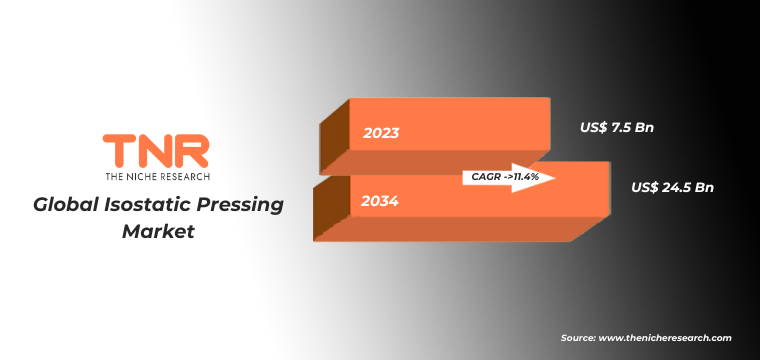
Global Isostatic Pressing Market Dynamics
Global Isostatic Pressing Market Growth Driver:
The global isostatic pressing market is driven by the growing demand for high-performance materials across industries such as aerospace, automotive, and healthcare. The increasing application of isostatic pressing in additive manufacturing and powder metallurgy is another key driver, as it enhances the mechanical properties and density of materials. Additionally, advancements in material science and the need for lightweight, durable components in industrial applications further fuel market growth. The expansion of the aerospace and defense sectors, particularly in developing regions, also significantly contributes to the rising adoption of isostatic pressing technologies worldwide.
Global Isostatic Pressing Market Restraint:
The global isostatic pressing market faces several challenges, including the high cost of equipment and maintenance, which can deter adoption, particularly among small and medium-sized enterprises. Additionally, the complexity of isostatic pressing processes requires specialized knowledge and skilled labor, which can limit market penetration in regions with a shortage of technical expertise. The long production cycles associated with isostatic pressing also pose a restraint, particularly in industries with time-sensitive manufacturing processes. Furthermore, economic uncertainties and fluctuations in raw material prices may impact the overall growth of the market.
Global Isostatic Pressing Market Opportunity:
The global isostatic pressing market presents significant opportunities for growth, particularly in emerging markets such as Asia-Pacific and Latin America, where industrialization is driving demand for advanced manufacturing technologies. The increasing focus on sustainability and the development of eco-friendly materials open new avenues for innovation in isostatic pressing. Additionally, the growing adoption of additive manufacturing across various industries offers opportunities for the integration of isostatic pressing to enhance the quality and performance of 3D-printed components. Investments in research and development to improve process efficiency and reduce operational costs further present growth prospects.
Global Isostatic Pressing Market Threats:
The global isostatic pressing market faces potential threats from alternative manufacturing technologies that offer faster and more cost-effective solutions. Economic downturns or geopolitical instability could negatively impact capital investments in advanced manufacturing equipment, slowing market growth. Stringent environmental regulations regarding the disposal of waste materials generated during the isostatic pressing process may pose compliance challenges for manufacturers. The rapid pace of technological advancements in competing methods, such as metal injection molding and conventional powder metallurgy, could also threaten the market’s growth trajectory by offering viable alternatives to isostatic pressing.
Global Isostatic Pressing Market Segmental Analysis:
Global Isostatic Pressing Market By Offering
Services segment has rapidly emerged as the fastest-growing segment in the global isostatic pressing market, driven by increasing demand for maintenance, retrofitting, and system upgrades as companies seek to enhance operational efficiency and extend the lifespan of their equipment. The rising complexity of isostatic pressing systems necessitates specialized expertise, fueling demand for installation and technical support services. Additionally, the growing adoption of automation and digital controls has created opportunities for service providers to offer software integration, monitoring, and training services, further propelling growth in this segment.
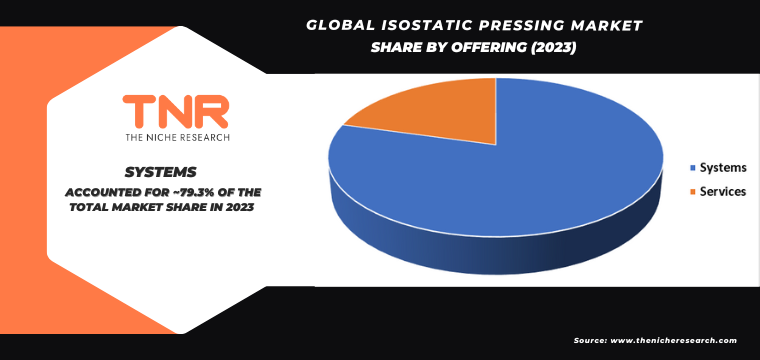
Global Isostatic Pressing Market By Type
In 2023, hot isostatic pressing (HIP) segment dominated the global isostatic pressing market, capturing a substantial revenue share of 68.2%. This dominance is attributed to HIP’s critical role in enhancing the density and mechanical properties of metal and ceramic components, making it indispensable in high-performance industries such as aerospace, automotive, and medical devices. The growing demand for defect-free, high-integrity parts in these sectors has fueled the adoption of HIP technology. Additionally, advancements in material science and the increasing application of HIP in additive manufacturing have further solidified its position as the leading segment in the market.
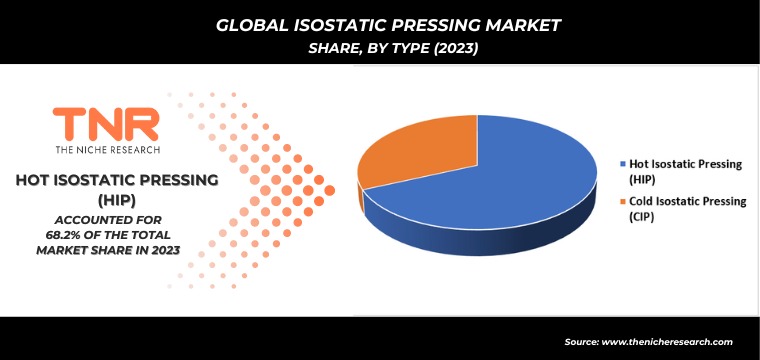
Global Isostatic Pressing Market By Process Type
Dry bag pressing segment dominated the global isostatic pressing market, with a revenue share of 69.3% due to its widespread adoption in manufacturing complex, high-precision components across industries such as aerospace, automotive, and electronics. This method’s ability to produce parts with uniform density and minimal material waste has made it highly desirable for applications requiring tight tolerances and consistent quality. Additionally, its cost-effectiveness and adaptability to various materials, including metals and ceramics, have further driven its dominance in the isostatic pressing market.
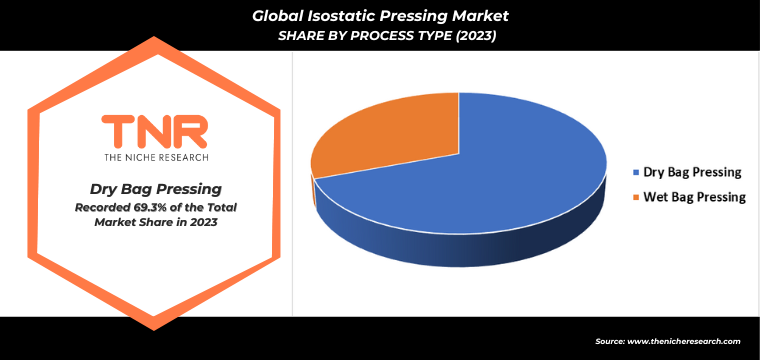
Global Isostatic Pressing Market By Capacity
Medium-sized HIP segment is anticipated to grow fastest in the global isostatic pressing market owing to its versatility and cost-effectiveness, making it ideal for small to medium-scale production runs. Industries such as aerospace, automotive, and medical devices increasingly prefer medium-sized HIP systems for their ability to deliver high-quality, defect-free components while maintaining operational efficiency. The growing trend toward customization and the production of specialized parts in smaller batches further drives demand for medium-sized HIP systems, positioning this segment for rapid growth as manufacturers seek flexible and efficient solutions.

Global Isostatic Pressing Market By End Use Industry
By end use industry, manufacturing segment is anticipated to grow fastest over the forecast timeline in global isostatic pressing market due to the increasing demand for high-performance, precision-engineered components across various sectors, including aerospace, automotive, and electronics. The manufacturing industry’s shift towards advanced materials, such as composites and high-strength alloys, has heightened the need for isostatic pressing techniques to achieve superior material properties and consistent quality. Additionally, the adoption of additive manufacturing and the need for post-processing treatments like hot isostatic pressing (HIP) are further driving growth, as manufacturers aim to enhance the performance and durability of critical components.
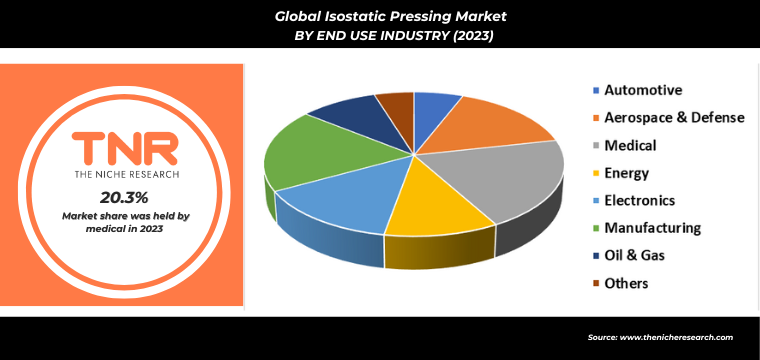
Isostatic Pressing Market By Region
Europe is projected to be the fastest-growing region in the isostatic pressing market during the forecast period, driven by the region’s strong industrial base and growing investments in advanced manufacturing technologies. Key industries such as aerospace, automotive, and healthcare are increasingly adopting isostatic pressing to meet the demand for high-performance, precision-engineered components. Europe’s focus on sustainability and innovation, along with government support for research and development in material science, is further propelling the market. The presence of leading manufacturing firms and a skilled workforce also contribute to the region’s rapid growth.
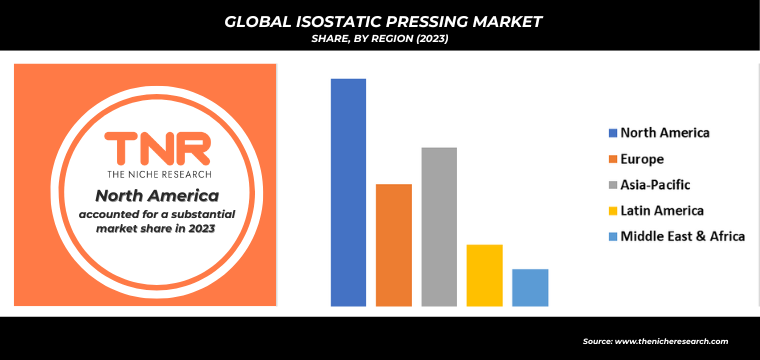
Competitive Landscape
The global isostatic pressing market is highly competitive, with key players focusing on technological advancements, strategic partnerships, and geographic expansion. Major companies are investing in R&D to enhance product offerings and maintain a competitive edge in the market.
Some of the players operating in the isostatic pressing market are
- American Isostatic Presses Inc
- Bodycote
- DORST Technologies GmbH & Co. KG
- EPSI
- Fluitron
- Höganäs AB
- Isostatic Pressing Services
- Kennametal Inc.
- Kittyhawk
- KMTI Corporation
- KOBE STEEL, LTD.
- Nikkiso Co., Ltd.
- Pressure Technology, Inc.
- PTC Industries
- Sandvik AB
- Shanxi Golden Kaiyuan Co., Ltd.
- Other Industry Participants
Key Developments:
- In April 2023, Quintus Technologies introduced a new toolbox designed to achieve unoxidized surfaces on parts after Hot Isostatic Pressing (HIP), eliminating the need for complex, costly, or hazardous pre- and post-treatment processes.
- In January 2023, Trive Capital acquired Kittyhawk, Inc., a leading provider of Hot Isostatic Pressing (HIP) services catering to sectors such as space, commercial aerospace, defense, and medical applications.
Global Isostatic Pressing Market Scope:
| Report Specifications | Details |
| Market Revenue in 2023 | US$ 7.5 Bn |
| Market Size Forecast by 2034 | US$ 24.5 Bn |
| Growth Rate (CAGR) | 11.4% |
| Historic Data | 2016 – 2022 |
| Base Year for Estimation | 2023 |
| Forecast Period | 2024 – 2034 |
| Report Inclusions | Market Size & Estimates, Market Dynamics, Competitive Scenario, Trends, Growth Factors, Market Determinants, Key Investment Segmentation, Product/Service/Solutions Benchmarking |
| Segments Covered | By Offering, By Type, By Process Type, By Capacity, By End Use Industry, By Region |
| Regions Covered | North America, Europe, Asia Pacific, Middle East & Africa, Latin America |
| Countries Covered | U.S., Canada, Mexico, Rest of North America, France, The UK, Spain, Germany, Italy, Nordic Countries (Denmark, Finland, Iceland, Sweden, Norway), Benelux Union (Belgium, The Netherlands, Luxembourg), Rest of Europe, China, Japan, India, New Zealand, Australia, South Korea, Southeast Asia (Indonesia, Thailand, Malaysia, Singapore, Rest of Southeast Asia), Rest of Asia Pacific, Saudi Arabia, UAE, Egypt, Kuwait, South Africa, Rest of Middle East & Africa, Brazil, Argentina, Rest of Latin America |
| Key Players | American Isostatic Presses Inc, Bodycote, DORST Technologies GmbH & Co. KG, EPSI, Fluitron, Höganäs AB, Isostatic Pressing Services, Kennametal Inc., Kittyhawk, KMTI Corporation, KOBE STEEL, LTD., Nikkiso Co., Ltd., Pressure Technology, Inc., PTC Industries, Sandvik AB, Shanxi Golden Kaiyuan Co., Ltd. |
| Customization Scope | Customization allows for the inclusion/modification of content pertaining to geographical regions, countries, and specific market segments. |
| Pricing & Procurement Options | Explore purchase options tailored to your specific research requirements |
| Contact Details | Consult With Our Expert
Japan (Toll-Free): +81 663-386-8111 South Korea (Toll-Free): +82-808- 703-126 Saudi Arabia (Toll-Free): +966 800-850-1643 United Kingdom: +44 753-710-5080 United States: +1 302-232-5106 E-mail: askanexpert@thenicheresearch.com
|
Global Isostatic Pressing Market Segmentation:
By Offering
- Systems
- Services
By Type
- Hot Isostatic Pressing (HIP)
- Cold Isostatic Pressing (CIP)
By Process Type
- Dry Bag Pressing
- Wet Bag Pressing
By Capacity
- Small-sized HIP
- Medium-sized HIP
- Large-sized HIP
By End Use Industry
- Automotive
- Aerospace & Defense
- Medical
- Energy
- Electronics
- Manufacturing
- Oil & Gas
- Others
By Region
- North America (U.S., Canada, Mexico, Rest of North America)
- Europe (France, The UK, Spain, Germany, Italy, Nordic Countries (Denmark, Finland, Iceland, Sweden, Norway), Benelux Union (Belgium, The Netherlands, Luxembourg), Rest of Europe)
- Asia Pacific (China, Japan, India, New Zealand, Australia, South Korea, Southeast Asia (Indonesia, Thailand, Malaysia, Singapore, Rest of Southeast Asia), Rest of Asia Pacific)
- Middle East & Africa (Saudi Arabia, UAE, Egypt, Kuwait, South Africa, Rest of Middle East & Africa)
- Latin America (Brazil, Argentina, Rest of Latin America)
Report Layout:
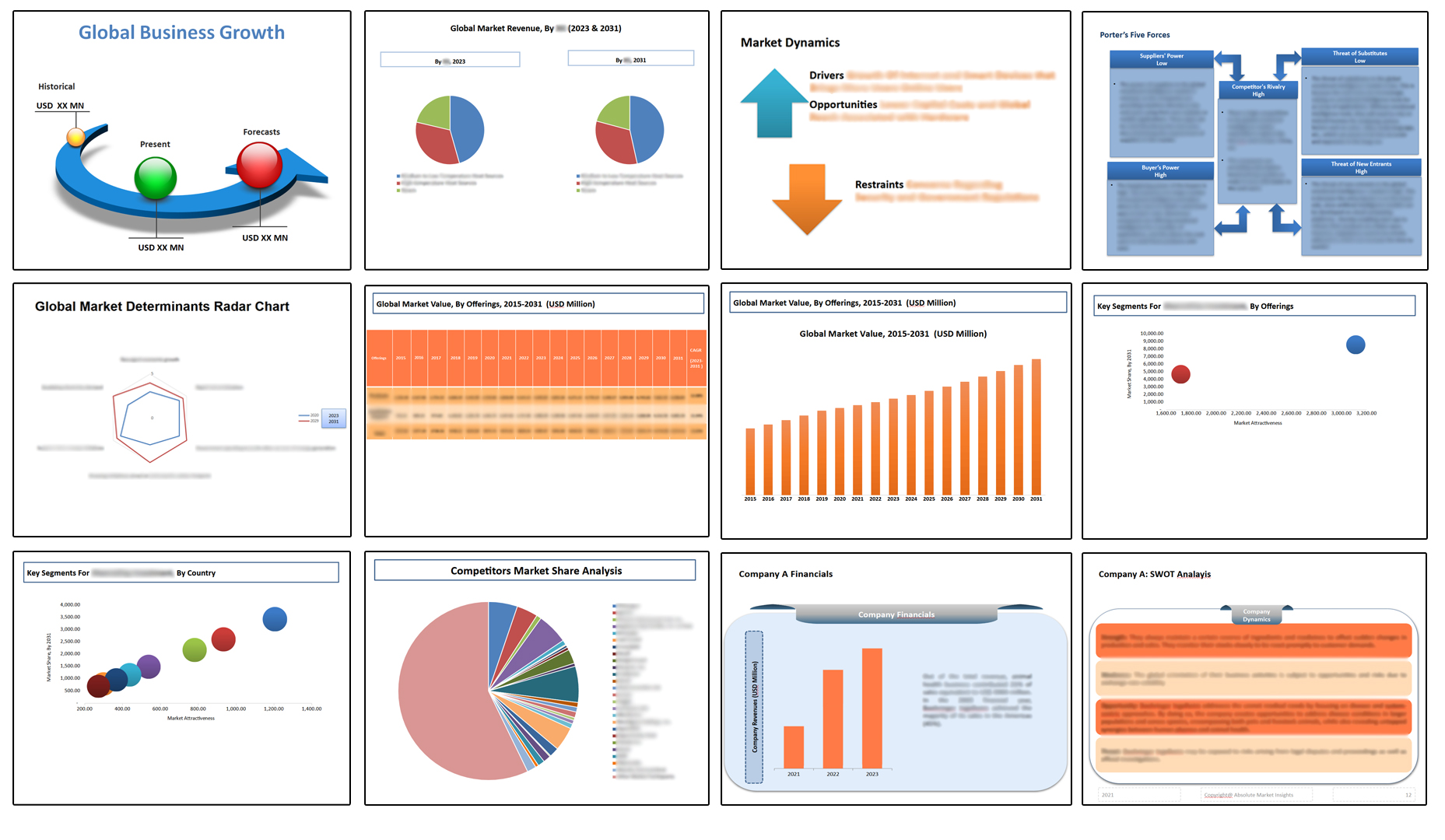
Table of Contents
Note: This ToC is tentative and can be changed according to the research study conducted during the course of report completion.
**Exclusive for Multi-User and Enterprise User.
Global Isostatic Pressing Market Segmentation:
By Offering
- Systems
- Services
By Type
- Hot Isostatic Pressing (HIP)
- Cold Isostatic Pressing (CIP)
By Process Type
- Dry Bag Pressing
- Wet Bag Pressing
By Capacity
- Small-sized HIP
- Medium-sized HIP
- Large-sized HIP
By End Use Industry
- Automotive
- Aerospace & Defense
- Medical
- Energy
- Electronics
- Manufacturing
- Oil & Gas
- Others
By Region
- North America (U.S., Canada, Mexico, Rest of North America)
- Europe (France, The UK, Spain, Germany, Italy, Nordic Countries (Denmark, Finland, Iceland, Sweden, Norway), Benelux Union (Belgium, The Netherlands, Luxembourg), Rest of Europe)
- Asia Pacific (China, Japan, India, New Zealand, Australia, South Korea, Southeast Asia (Indonesia, Thailand, Malaysia, Singapore, Rest of Southeast Asia), Rest of Asia Pacific)
- Middle East & Africa (Saudi Arabia, UAE, Egypt, Kuwait, South Africa, Rest of Middle East & Africa)
- Latin America (Brazil, Argentina, Rest of Latin America)
The Niche Research approach encompasses both primary and secondary research methods to provide comprehensive insights. While primary research is the cornerstone of our studies, we also incorporate secondary research sources such as company annual reports, premium industry databases, press releases, industry journals, and white papers.
Within our primary research, we actively engage with various industry stakeholders, conducting paid interviews and surveys. Our meticulous analysis extends to every market participant in major countries, allowing us to thoroughly examine their portfolios, calculate market shares, and segment revenues.
Our data collection primarily focuses on individual countries within our research scope, enabling us to estimate regional market sizes. Typically, we employ a bottom-up approach, meticulously tracking trends in different countries. We analyze growth drivers, constraints, technological innovations, and opportunities for each country, ultimately arriving at regional figures.Our process begins by examining the growth prospects of each country. Building upon these insights, we project growth and trends for the entire region. Finally, we utilize our proprietary model to refine estimations and forecasts.
Our data validation standards are integral to ensuring the reliability and accuracy of our research findings. Here’s a breakdown of our data validation processes and the stakeholders we engage with during our primary research:
- Supply Side Analysis: We initiate a supply side analysis by directly contacting market participants, through telephonic interviews and questionnaires containing both open-ended and close-ended questions. We gather information on their portfolios, segment revenues, developments, and growth strategies.
- Demand Side Analysis: To gain insights into adoption trends and consumer preferences, we reach out to target customers and users (non-vendors). This information forms a vital part of the qualitative analysis section of our reports, covering market dynamics, adoption trends, consumer behavior, spending patterns, and other related aspects.
- Consultant Insights: We tap into the expertise of our partner consultants from around the world to obtain their unique viewpoints and perspectives. Their insights contribute to a well-rounded understanding of the markets under investigation.
- In-House Validation: To ensure data accuracy and reliability, we conduct cross-validation of data points and information through our in-house team of consultants and utilize advanced data modeling tools for thorough verification.
The forecasts we provide are based on a comprehensive assessment of various factors, including:
- Market Trends and Past Performance (Last Five Years): We accurately analyze market trends and performance data from preceding five years to identify historical patterns and understand the market’s evolution.
- Historical Performance and Growth of Market Participants: We assess the historical performance and growth trajectories of key market participants. This analysis provides insights into the competitive landscape and individual company strategies.
- Market Determinants Impact Analysis (Next Eight Years): We conduct a rigorous analysis of the factors that are projected to influence the market over the next eight years. This includes assessing both internal and external determinants that can shape market dynamics.
- Drivers and Challenges for the Forecast Period:Identify the factors expected to drive market growth during the forecast period, as well as the challenges that the industry may face. This analysis aids in deriving an accurate growth rate projection.
- New Acquisitions, Collaborations, or Partnerships: We keep a close watch on any new acquisitions, collaborations, or partnerships within the industry. These developments can have a significant impact on market dynamics and competitiveness.
- Macro and Micro Factors Analysis:A thorough examination of both macro-level factors (e.g., economic trends, regulatory changes) and micro-level factors (e.g., technological advancements, consumer preferences) that may influence the market during the forecast period.
- End-User Sentiment Analysis: To understand the market from the end-user perspective, we conduct sentiment analysis. This involves assessing the sentiment, preferences, and feedback of the end-users, which can provide valuable insights into market trends.
- Perspective of Primary Participants: Insights gathered directly from primary research participants play a crucial role in shaping our forecasts. Their perspectives and experiences provide valuable qualitative data.
- Year-on-Year Growth Trend: We utilize a year-on-year growth trend based on historical market growth and expected future trends. This helps in formulating our growth projections, aligning them with the market’s historical performance.
Research process adopted by TNR involves multiple stages, including data collection, validation, quality checks, and presentation. It’s crucial that the data and information we provide add value to your existing market understanding and expertise. We have also established partnerships with business consulting, research, and survey organizations across regions and globally to collaborate on regional analysis and data validation, ensuring the highest level of accuracy and reliability in our reports.








